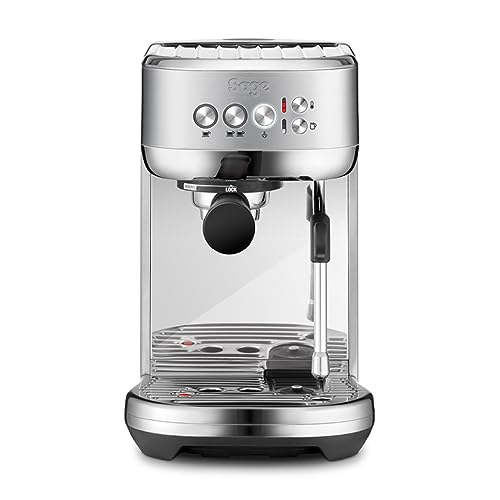How to Make Espresso Machine Coffee
Espresso machines can make a delicious cup, but they require more care and setup than a typical coffee maker. It is also necessary to grind and tamp the beans yourself.
The secret to making espresso is pressure. Here's how an espresso machine works: a heating vessel is used to heat water to a suitable temperature, and then pushes it through the grounds and out the spouts.
Temperature
Espresso is made when hot water is forced under pressure through finely ground coffee. The temperature of the water is vital to the quality of the final shot. Insufficient temperatures cause absence of flavor compounds. High temperatures can lead to excessive extraction, which could cause bitter or burnt taste.
The ideal temperature for espresso is between 195 and 205degF. This temperature can be achieved by using a grouphead that is designed to maintain the same temperature and stability throughout the brewing process. The most popular kind of group head is the E61 that provides an array of temperature stability as well as pre-infusion capabilities and lever control.
It is important to consider the temperature when adjusting your espresso machine for different roasts or brew ratios. This will affect the extraction yield and the crema. The ideal temperature will depend on the specific bean and roast however, the general rule is that lighter roasts and greater ratios of brews need higher temperatures than dark roasts and lower ratios of brew. Additionally, a high thermocouple that is of high-quality will be crucial to ensure a constant temperature.
Pressure
When brewing, espresso machine coffee is pushed through finely ground coffee grounds that have been tamped. This causes chemical reactions to extract flavors oils, flavors and other soluble ingredients from the beans. The resultant beverage is usually richer and more flavorful.
The ideal espresso machine's pressure is nine bars of pressure which is equivalent to the atmospheric pressure at sea level. This is because it's at this pressure the soluble compounds of espresso are most easily extracted.
However some espresso machines advertise 15 or even 20 bars of pressure. While these machines may reach these levels of pressure however, they may not be able to maintain that level of pressure throughout the extraction.
To put it in perspective To put it in perspective, one bar of pressure equals 32 pounds per square inch, or PSI, of the tire of a car. best espresso machine uk 's nearly four times the pressure a professional cyclist applies to their bicycle tires. The ability to control espresso machine's pressure and produce consistent espressos is essential for any serious barista at home.
Water
Water is a key ingredient in a good cup of espresso. The correct water can help your beans reach their full potential. However, the wrong water could cause problems like clogging pipes and even damage your expensive machine.
For the best espresso extraction make sure you choose an untreated natural spring with a high mineral content. This water will enhance the taste of your espresso without chalky mineral traces that are found in tap water or bottled water. This is an excellent alternative to distilled water or reverse osmosis, which could be too pure and cause taste issues.
You should not use a water filtering system that removes excessive mineral content from the water you drink. This can result in flavor and extraction issues. A great option is to buy a water test kit, which will provide you with the average hardness of your water in your area. This can be used to identify a filtration system that will give you the correct specifications for the water in your espresso machine.
Beans
The majority of coffee lovers become enthralled in the whole process of making espresso. They obsess about a number factors, such as temperature, pressure of water and viscosity. If one of the variables is not in order the whole shot may taste bad.
The beans used are the most important factor when it comes to espresso. It is often believed that only certain types of beans are suitable for espresso. While some beans are suitable for certain uses however, any coffee bean that has been roasted can be used to make espresso. Espresso beans are roasted for longer than regular coffee beans, and tipycally over the second crack. This gives them a darker appearance and makes them more water-soluble.
The best espresso beans are typically medium roasted or dark roasted, which gives the espressos their distinctive richness and boldness. However, it is possible to make excellent espresso with light roasted beans, particularly if these beans are pre-ground (for convenience in an espresso machine).
Milk
Espresso and milk are a traditional combination. Not only does the coffee increase energy levels, but the steaming milk helps to offset the bitterness of the espresso and adds a delicious creamy flavor. There aren't many culinary combinations more perfect than this!

When selecting an espresso maker capable of making latte, or cappuccino too it is important to consider how easy it is to use. A lot of the top espresso machines come with the jug which can be filled with hot or cold milk along with a steam wand as well as a portafilter that allows you to take the shot. Some models also come with an integrated grinder or tamper.
To eliminate any condensed water, the steam wand must be purged each day before use (or after each espresso cup). This process is only 30 seconds, but is essential to keep your machine running smoothly. Failure to purge can cause a bitter taste or build-up of bacteria that can affect the flavor and smell of your drinks. It's simple to perform and should be a part of your routine maintenance routine.
